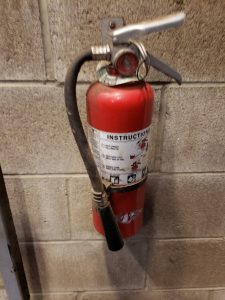Most jurisdictions have some sort of fire code which requires fire protection systems to be in place. The majority of these fire codes are thick and cumbersome. You are also thinking, how are they applicable to anyone but the builder/designer of the building who is supposed to decide where the fire doors go or the fire department. How is this applicable to me and my operations?
The main thing to look out for are the maintenance activities, such as inspections, that have to happen regularly that are usually the responsibility of the owner. You are either the owner or the owner has downloaded the responsibility to your organization through the lease or you are just a tenant and want to ensure that everything is being done to protect you are your colleagues.
Maintenance activities usually focus around fire extinguishers, fire suppression systems and life saving equipment, such as emergency lighting. (I am going to focus on the requirements of the Ontario Fire Code, but if anyone out there would like to know about the equivalencies in their jurisdiction, just send me an email.) Often the details are referenced out to another standard, such as the NFPA (National Fire Protection Association). Once a standard is referenced from a regulation, then that standard is also enforceable like a regulation.
Fire prevention and protection are applicable to both health and safety purposes, your business, as well as the environment. For Safety, the fire systems you install will help employees escape safely. For the business, the fire prevention and early detection protect your assets, inventory and reduce downtime. For the environment, a fire has some of the worst environmental impacts, from the uncontrolled combustion of materials that were never intended to be burned, to the waste generated and the contaminated fire water going to the storm sewers untreated.
First, it is important to distinguish between checking, inspecting and testing, because there are different expectations: (O.Reg. 213/07:Fire Code)
Check means visual observation to ensure the device or system is in place and is not obviously damaged or obstructed.
Inspection means physical examination to determine that the device or system will apparently perform in accordance with its intended function.
Test means the operation of a device or system to ensure that it will perform in accordance with its intended operation or function.
Second, know what equipment you have and who is responsible for it.
Fire Extinguishers, once the number, type and location are determined, the following maintenance activities need to be inspected monthly in conformance with the NFPA 10 “Portable Fire Extinguishers” standard. This includes more than a visual check. There should be some training or competency established for the persons performing the inspections. The inspection shall include activities such as, but not limited to:
- Verifying its location and checking for obstructions and accessibility
- Checking the pressure gauge is in range
- Its fullness by lifting or weighing
- Verifying the labels, name plates, instructions, seals and other equipment is not broken or missing
- Checking for corrosion physical damage or leakage
In addition to the monthly inspections, the fire extinguishers need to be hydrostatically tested and the frequency of re-testing depends on the type of extinguisher.
Fire Alarm Systems, including interconnected smoke alarm systems, must have annual tests and inspections performed. But this is just part of it depending on what your system consists of.
- Monthly tests of the voice communication systems connected with the fire alarm system.
- Power supply for interconnected smoke alarms shall be checked weekly.
- Test at least one interconnected smoke alarm monthly
Sprinkler systems and other fire suppression systems have multiple requirements for testing and inspection. It is dependent on the type of equipment installed. There may also be variable requirements from annual certification to weekly verification of water pressure.
Emergency lighting shall be checked monthly for operation. But the Fire Code doesn’t just require that the little test button be pushed and then move on. There are inspection requirements looking for corrosion around terminals and battery condition. Also, there are monthly and annual testing requirements for the emergency lighting to ensure that it works for the expected duration.
Finally, maintain records. The old adage: “If it wasn’t written down, it didn’t happen.” Is very applicable.
This article is not complete and not intended to be an interpretation of the law, just additional guidance in the start of your journey to understand your compliance requirements. If you require further detailed help, drop us a line and we can come in and conduct a compliance audit and let you know where we stand. We are not lawyers, just effective and experienced auditors.
Check out our Compliance page our on website for more information.

